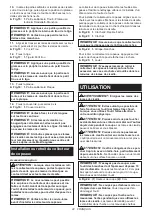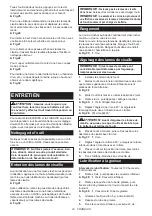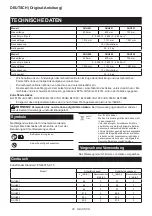
10
ENGLISH
8.
Use the hedge trimmer only if you are in good
physical condition.
If you are tired, your attention will
be reduced. Be especially careful at the end of a work
-
ing day. Perform all work calmly and carefully. The
user is responsible for all damages to third parties.
9.
Never use the trimmer when under the influ
-
ence of alcohol, drugs or medication.
10.
Work gloves of stout leather are part of the
basic equipment of the hedge trimmer and
must always be worn when working with it.
Also wear sturdy shoes with anti-skid soles.
11.
Before starting work check to make sure that the
trimmer is in good and safe working order. Ensure
guards are fitted properly. The hedge trimmer
must not be used unless fully assembled.
12.
Make sure you have a secure footing before
starting operation.
13.
Hold the tool firmly when using the tool.
14.
Do not operate the tool at no-load unnecessarily.
15.
Immediately switch off the motor and remove
the battery cartridge if the cutter should come
into contact with a fence or other hard object.
Check the cutter for damage, and if damaged
repair immediately
.
16.
Before checking the cutter, taking care of
faults, or removing material caught in the cut-
ter, always switch off the trimmer and remove
the battery cartridge.
17.
Switch off the trimmer and remove the battery
cartridge before doing any maintenance work.
18.
When moving the hedge trimmer to another
location, including during work, always
remove the battery cartridge and put the blade
cover on the cutter blades. Never carry or
transport the trimmer with the cutter running.
Never grasp the cutter with your hands.
19.
Clean the hedge trimmer and especially the
cutter after use, and before putting the trimmer
into storage for extended periods. Lightly oil the
cutter and put on the cover.
The cover supplied
with the unit can be hung on the wall, providing a
safe and practical way to store the hedge trimmer.
20.
Store the hedge trimmer with the cover on, in
a dry room. Keep it out of reach of children.
Never store the trimmer outdoors.
21.
Never point the shear blades to yourself or others.
22.
If the blades stop moving due to the stuck of
foreign objects between the blades during
operation, switch off the tool and remove the
battery cartridge, and then remove the foreign
objects using tools such as pliers.
Removing
the foreign objects by hand may cause an injury
for the reason that the blades may move in reac
-
tion to removing the foreign objects.
23.
Avoid dangerous environment. Don't use the
tool in damp or wet locations or expose it to
rain. Water entering the tool will increase the
risk of electric shock.
24.
Do not dispose of the battery(ies) in a fire. The
cell may explode. Check with local codes for
possible special disposal instructions.
25.
Do not open or mutilate the battery(ies). Released
electrolyte is corrosive and may cause damage to
the eyes or skin. It may be toxic if swallowed.
26.
Do not charge battery in rain, or in wet locations.
27.
Check the hedges and bushes for foreign
objects, such as wire fences or hidden wiring
before operating the tool.
SAVE THESE INSTRUCTIONS.
WARNING:
DO NOT let comfort or familiarity
with product (gained from repeated use) replace
strict adherence to safety rules for the subject
product. MISUSE or failure to follow the safety
rules stated in this instruction manual may cause
serious personal injury.
Important safety instructions for
battery cartridge
1.
Before using battery cartridge, read all instruc-
tions and cautionary markings on (1) battery
charger, (2) battery, and (3) product using battery.
2.
Do not disassemble battery cartridge.
3.
If operating time has become excessively
shorter, stop operating immediately. It may
result in a risk of overheating, possible burns
and even an explosion.
4.
If electrolyte gets into your eyes, rinse them out
with clear water and seek medical attention right
away. It may result in loss of your eyesight.
5.
Do not short the battery cartridge:
(1)
Do not touch the terminals with any con-
ductive material.
(2)
Avoid storing battery cartridge in a con-
tainer with other metal objects such as
nails, coins, etc.
(3)
Do not expose battery cartridge to water
or rain.
A battery short can cause a large current flow,
overheating, possible burns and even a breakdown.
6.
Do not store the tool and battery cartridge in
locations where the temperature may reach or
exceed 50 °C (122 °F).
7.
Do not incinerate the battery cartridge even if
it is severely damaged or is completely worn
out. The battery cartridge can explode in a fire.
8.
Be careful not to drop or strike battery.
9.
Do not use a damaged battery.
10.
The contained lithium-ion batteries are subject to
the Dangerous Goods Legislation requirements.
For commercial transports e.g. by third parties,
forwarding agents, special requirement on pack
-
aging and labeling must be observed.
For preparation of the item being shipped, consulting an
expert for hazardous material is required. Please also
observe possibly more detailed national regulations.
Tape or mask off open contacts and pack up the
battery in such a manner that it cannot move
around in the packaging.
11.
Follow your local regulations relating to dis-
posal of battery.
12.
Use the batteries only with the products
specified by Makita.
Installing the batteries to
non-compliant products may result in a fire, exces
-
sive heat, explosion, or leak of electrolyte.
SAVE THESE INSTRUCTIONS.
Summary of Contents for DUH751
Page 2: ...1 2 3 Fig 1 1 2 Fig 2 1 Fig 3 2 1 Fig 4 1 2 3 Fig 5 2 1 Fig 6 1 Fig 7 1 Fig 8 2 ...
Page 3: ...1 2 Fig 9 1 Fig 10 1 5 2 3 4 Fig 11 1 2 Fig 12 1 1 Fig 13 1 Fig 14 3 ...
Page 4: ...1 2 3 4 5 Fig 15 1 2 Fig 16 1 2 Fig 17 1 2 Fig 18 2 1 Fig 19 1 1 2 Fig 20 1 Fig 21 4 ...
Page 5: ...1 Fig 22 1 Fig 23 1 2 Fig 24 Fig 25 Fig 26 Fig 27 Fig 28 Fig 29 5 ...
Page 6: ...Fig 30 Fig 31 Fig 32 1 Fig 33 Fig 34 1 2 Fig 35 1 2 Fig 36 1 Fig 37 6 ...
Page 7: ...1 2 Fig 38 2 1 Fig 39 7 ...
Page 95: ...95 ...











































